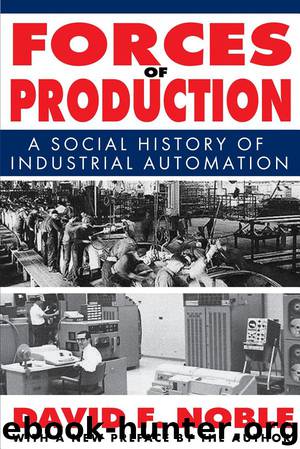Forces of production by David F. Noble

Author:David F. Noble
Language: eng
Format: epub
Publisher: A. Knopf
While Parsons was trying in vain to commercialize N/C, others were getting into the act. Directly or indirectly supported by the Air Force, Giddings and Lewis, together with General Electric, and Kearney and Trecker, together with Bendix, were already developing their own systems, with MIT's full cooperation. Giddings and Lewis was in the process of developing a numerically controlled skin mill for Lockheed, in cooperation with General Electric and MIT, and at Air Force expense. Originally, as we have seen, the system was intended to be a record-playback-controlled device but, in 1953, G&L contracted with MIT to develop a digital-to-analog conversion computer, a so-called Director, which could produce the magnetic tape for the machine controls from numerical data input on punched tape. Once the prototype Director, the heart of the "Numericord" system, was developed, G&L requested the MIT personnel to build more of them and eventually provided the backing to set up some of the MIT Servo Lab group in their own new company, Concord Controls, for this purpose. The Lockheed skin mill, meanwhile, was successfully demonstrated for the Air Force in 1955.6
The Glenn Martin Company's interest in numerical control began in 1953, following MIT's demonstration of the milling machine. Institute personnel visited Martin in Baltimore to discuss their project and commercial possibilities, did some machining of Martin fittings as part of their machine capabilities evaluation, and acted as a go-between with the Air Force. Later, MIT helped Martin with its proposal to the Air Force for a production milling machine modelled upon the MIT equipment and, when it was approved, served as informal consultants on the company project. Initially, Martin requested MIT to build its machine but, under pressure from the "outside activities" committee at the Institute, the Servo Lab had to decline, in Reintjes's words, so as to "avoid taking on jobs which can be done equally well or better by an industrial organization." Laboratory staff did offer technical assistance on an informal basis, however, and, more important, MIT brought Martin together with Bendix Aviation (where the research and development activities along these lines were under the direction of Albert Hall, previously associate director of the Servo Lab and Pease's former boss). Ultimately, with Air Force sponsorship, Bendix and Kearney and Trecker built the Martin machine, which was the first MIT-type numerical control system to be used for actual industrial production, beginning in 1957.7
Download
This site does not store any files on its server. We only index and link to content provided by other sites. Please contact the content providers to delete copyright contents if any and email us, we'll remove relevant links or contents immediately.
Whiskies Galore by Ian Buxton(40331)
Introduction to Aircraft Design (Cambridge Aerospace Series) by John P. Fielding(32338)
Small Unmanned Fixed-wing Aircraft Design by Andrew J. Keane Andras Sobester James P. Scanlan & András Sóbester & James P. Scanlan(32141)
Craft Beer for the Homebrewer by Michael Agnew(17446)
Turbulence by E. J. Noyes(7039)
The Complete Stick Figure Physics Tutorials by Allen Sarah(6638)
Kaplan MCAT General Chemistry Review by Kaplan(6053)
The Thirst by Nesbo Jo(5785)
Bad Blood by John Carreyrou(5769)
Learning SQL by Alan Beaulieu(5411)
Weapons of Math Destruction by Cathy O'Neil(5036)
Man-made Catastrophes and Risk Information Concealment by Dmitry Chernov & Didier Sornette(4735)
iGen by Jean M. Twenge(4702)
Digital Minimalism by Cal Newport;(4540)
Life 3.0: Being Human in the Age of Artificial Intelligence by Tegmark Max(4507)
Audition by Ryu Murakami(4099)
1,001 ASVAB Practice Questions For Dummies by Powers Rod(4038)
Electronic Devices & Circuits by Jacob Millman & Christos C. Halkias(4027)
Pale Blue Dot by Carl Sagan(4001)
